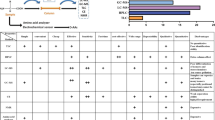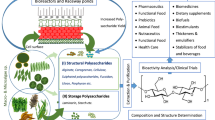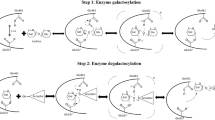Abstract
Two novel sugar acid-binding lectins were purified from Haplomitrium mnioides (Lindb.) Schust. using a procedure consisting of ammonium sulfate precipitation, G-50 gel filtration, hydroxyapatite chromatography, and HW-50 gel filtration. We reported their partial physicochemical properties: molecular weight, affinity for carbohydrates and organic acids, pH stability, and dependence of their hemagglutination activity on metal ions. We also determined their N-terminal amino acid sequences. H. mnioides lectins (HMLs) were monomers (one with a molecular weight of approximately 27 kDa, and the other with a molecular weight of approximately 105 kDa) under both nonreducing and reducing conditions. They were named HML27 and HML105, respectively. Both HMLs had an affinity for N-acetylneuraminic acid, d-glucuronic acid, d-glucaric acid, bovine submaxillary mucin, heparin, and organic acids, such as citrate, 2-oxoglutaric acid, and d-2-hydroxyglutarate. Furthermore, HML27 had an affinity for α-d-galacturonic acid, d-malate, l-malate, and pyruvate, while HML105 had an affinity for d-gluconic acid. HML27 and HML105 are novel plant lectins: they have an affinity for sugar acids and organic acids and specifically recognize the carboxyl group, and there is no homology between their N-terminal amino acid sequences and those of the previously described lectins and agglutinins.


Similar content being viewed by others
Abbreviations
- AGL :
-
Aplysia depilans lectin
- AS :
-
Ammonium sulfate
- Asp :
-
Aspartic acid
- BCA :
-
Bicinchoninic acid
- BRA :
-
Semibalanus roseus agglutinin
- BLAST :
-
Basic local alignment search tool
- BSM :
-
Bovine submaxillary mucin
- CS :
-
Chondroitin sulfate
- CS2 :
-
Coli surface antigen
- CV :
-
Column volume
- D2HG :
-
d-2-Hydroxyglutarate
- ECM :
-
Extracellular matrix
- EDTA :
-
Ethylenediaminetetraacetic acid
- Fuc :
-
Fucose
- Gal :
-
Galactose
- GalA :
-
Galacturonic acid
- GalNAc :
-
N-acetyl-galactosamine
- Glc :
-
Glucose
- GlcA :
-
Glucuronic acid
- GlcNAc :
-
N-acetyl-glucosamine
- Glu :
-
Glutamic acid
- GAG :
-
Glycosaminoglycan
- HA :
-
Hemagglutination activity
- HEL :
-
Hericium erinaceum lectin
- HHL :
-
Human heparin lectin
- HML :
-
Haplomitrium mnioides lectin
- IDH :
-
Isocitrate dehydrogenase
- IdoA :
-
Iduronic acid
- IEW :
-
Ion-exchanged distilled water
- KDM :
-
Histone lysine demethylase
- Lac :
-
Lactose
- LCA :
-
Lens culinaris agglutinin
- MAA :
-
Maackia amurensis hemagglutinin
- MAC :
-
Minimum agglutination concentration
- MAL :
-
Maackia amurensis leukoagglutinin
- Man :
-
Mannose
- MLA-I :
-
Meretrix lusoria lectin
- NANA :
-
N-Acetylneuraminic acid
- PB :
-
Phosphate buffer
- PHD :
-
Prolyl hydroxylase
- PJA :
-
Paecilomyes japonica agglutinin
- PSA :
-
Polyporus squamosus agglutinin
- Rha :
-
Rhamnose
- SAA :
-
Sialic acid-binding agglutinin
- SBL-C :
-
Rana catesbeiana lectin
- scorpion :
-
Heterometrus granulomanus lectin
- SDS-PAGE :
-
Sodium dodecyl sulfate-polyaclylamidegel electrophoresis
- SNA-I :
-
Sambucus nigra agglutinin
- SPL-I :
-
Apostichopus japonicus lectin
- TB :
-
Tris-HCl buffer
- TET :
-
Ten–eleven translocation
- TFL :
-
Tritrichomonas fetus lectin
- TML :
-
Tritrichomonas mobilensis lectin
- w/v :
-
Weight/volume
- Xyl :
-
Xylose
References
Ceri, H., Hwang, S. W., & Cheung, H. (1990). Endogenous heparin-binding lectin activity in human placenta: purification and developmental expression. Biochemistry and Cell Biology, 68, 790–795.
Rutishauser, U., & Sachs, L. (1975). Cell-to-cell binding induced by different lectins. Journal of Cell Biology, 65, 247–257.
Burger, M. M. (1971). Surface changes detected by lectins and implications for growth regulation in normal and in transformed cells. Biomembranes, 2, 247–270.
Hajto, T., Hostanska, K., & Gabius, H. J. (1989). Modulatory potency of the β-galactoside-specific lectin from mistletoe extract (Iscador) on the host defense system in vivo in rabbits and patients. Cancer Research, 49, 4803–4808.
Ohno, Y. I., Hirai, K. I., Kanoh, T., Uchino, H., & Ogawa, K. (1982). Subcellular localization of hydrogen peroxide production in human polymorphonuclear leukocytes stimulated with lectins, phorbol myristate acetate, and digitonin: an electron microscopic study using CeCl3. Blood, 60, 1195–1202.
Gabius, H. J., Engelhardt, R., Casper, J., Reile, D., Schumacher, S., Schmoll, H. J., et al. (1985). Cell surface lectins of transplantable human teratocarcinoma cells: purification of a new mannan-specific endogenous lectin. Tumour Biology: the Journal of the International Society for Oncodevelopmental Biology and Medicine, 6, 145–156.
Yen, E. S., Mansfield, M. J., Levine, F. R., & Wallace, H. J. (1981). The prickly lettuce agglutinin. II. Immunobiological properties. International Archives of Allergy and Applied Immunology, 65, 445–450.
Kolb, H., Oschilewski, M., Schwab, E., Greulich, B., Roos, P., & Kiesel, U. (1986). Suppression of low-dose streptozotocin-induced diabetes by immunomodulatory lectins. Diabetes Research, 3, 183–186.
Smith, W. W. (1940). Production of antibacterial agglutinins by carp and trout at 10°C. Proceedings of the Society for Experimental Biology and Medicine, 45, 726–729.
Besancon, F., & Ankel, H. (1974). Inhibition of interferon action by plant lectins. Nature, 250, 784–786.
Ito, M., & Barron, L. A. (1974). Inactivation of herpes simplex virus by concanavalin A. Journal of Virology, 13, 1312–1318.
Lin, J., Tserng, K., Chen, C., Lin, L., & Tung, T. (1970). Abrin and ricin: a new antitumor substances. Nature, 227, 292–293.
Kim, M., Rao, V. M., Tweardy, J. D., Prakash, M., Galili, U., & Gorelik, E. (1993). Lectin-induced apoptosis of tumor cells. Glycobiology, 3, 447–553.
Lorenc-Kubis, I., Morawiecka, B., Wieczorek, E., Wisniowska, J., Wierzba, E., & Ferens, M. (1981). Effects of lectins on enzymatic properties plant acid phosphatases and ribonucleases. In T. C. Bøg-Hansen (Ed.), Lectins: biology, biochemistry, clinical biochemistry. 1, Proceedings of 3rd Lectin Meeting, Copenhagen (pp. 169–178). Germany: Walter De Gruyter Inc.
Nitta, K., Oyama, F., Oyama, R., Sekiguchi, K., Kawauchi, H., Takayanagi, Y., et al. (1993). Ribonuclease activity of sialic acid-binding lectin from Rana catesbeiana eggs. Glycobiology, 3, 37–45.
Nowell, C. P. (1960). Phytohemagglutinin: an initiator of mitosis in cultures of normal human leukocytes. Cancer Research, 20, 462–466.
Farnes, P., Barker, E. B., Brownhill, E. L., & Fanger, H. (1964). Mitogenic activity in Phytolacca americana (Pokeweed). The Lancet, 2, 1100–1101.
Ceri, H., Shadle, P. J., Kobiler, D., & Barondes, S. H. (1979). Extracellular lectin and its glycosaminoglycan inhibitor in chick muscle cultures. Journal of Supramolecular Structure, 11, 61–67.
Chowdhury, M., Sarkar, M., & Mendal, C. (1985). Identification and isolation of an agglutinin from uterus of rats. Biochemical and Biophysical Research Communications, 130, 1301–1307.
Nitta, K., Ozaki, K., Ishikawa, M., Furusawa, S., Hosono, M., Kawauchi, H., et al. (1994). Inhibition of cell proliferation by Rana catesbeiana and Rana Japonica lectins belonging to the ribonuclease superfamily. Cancer Research, 54, 920–927.
Ahmed, H., Chatterjee, P. B., Kelm, S., & Schauer, R. (1986). Purification of a sialic acid-specific lectin from the Indian scorpion Heterometrus granulomanus. Biological Chemistry Hoppe-Seyler, 367, 501–506.
Nowak, P. T., & Barondes, H. S. (1975). Agglutinin from Limulus polyphemus, purification with formalinized horse erythrocytes as the affinity adsorbent. Biochimica et Biophysica Acta, 393, 115–123.
Amanai, K., Sakurai, S., & Ohtaki, T. (1990). Purification and characterization of haemagglutinin in the haemolymph of the silkworm, Bombyx mori. Comparative Biochemistry and Physiology. B. Comparative Biochemistry, 97, 471–476.
Yamazaki, M., Esumi-Kurisu, M., Mizuno, D., Ogata, K., & Kamiya, H. (1983). Marine animal lectin-dependent tumor recognition by macrophages. Gann: Japanese Journal of Cancer Research, 74, 405–411.
Kamiya, H., & Ogata, K. (1982). Hemagglutinins in the acorn barnacle Balanus (Megabalanus) roseus: purification and partial characterization. Bulletin of the Japanese Society of Scientific Fisheries, 48, 1421–1425.
Gilboa-Garber, N., Susswein, J. A., Mizrahi, L., & Avichezer, D. (1985). Purification and characterization of the gonad lectin of Aplysia depilans. FEBS Letters, 181, 267–270.
Kamiya, H., & Shimizu, Y. (1981). A natural agglutinin inhibitable by D-galacturonic acid in the sea hare Aplysia eggs: characterization and purification. Bulletin of the Japanese Society of Scientific Fisheries, 47, 255–259.
Kamiya, H., Muramoto, K., & Goto, R. (1990). Purification and characterization of a lectin from a marine sponge Halichondria panicea. Bulletin of the Japanese Society of Scientific Fisheries, 56, 1159.
Matsui, T., Ozeki, Y., Suzuki, M., Hino, A., & Titani, K. (1994). Purification and characterization of two Ca2+-dependent lectins from coelomic plasma of sea cucumber, Stichopus japonicus. The Journal of Biochemistry, 116, 1127–1133.
Kim, H. J., Chung, R. S., & Jeune, H. K. (1990). Lectin from marine shells (IX): purification and carbohydrates specificities of a lectin, MLA-1, from the hemolymph of Meretrix lusoria. The Korean Journal of Biochemistry, 23, 328–334.
Broekaert, F. W., Nsimba-Lubaki, M., Peeters, B., & Peumans, J. W. (1984). A lectin from elder (Sambucus nigra L.) bark. The Biochemical Journal, 221, 163–169.
Lam, S. K., & Ng, T. B. (2009). Novel galactonic acid-binding hexameric lectin from Hibiscus mutabilis seeds with antiproliferative and potent HIV-1 reverse transcriptase inhibitory activities. Acta Biochimica Polonica, 56, 649–654.
Rutherford, M. W., Dick, E. W., Cavins Jr., F. J., Dombrink-Kurtzman, A. M., & Slodki, E. M. (1986). Isolation and characterization of a soybean lectin having 4-O-methylglucuronic acid specificity. Biochemistry, 25, 952–958.
Chan, Y. S., Wong, J. H., & Ng, T. B. (2011). A glucuronic acid binding leguminous lectin with mitogenic activity toward mouse splenocytes. Protein & Peptide Letters, 18, 194–202.
Kawagishi, H., Mori, H., Uno, A., Kimura, A., & Chiba, S. (1994). A sialic acid-binding lectin from the mushroom Hericium erinaceum. FEBS Letters, 340, 56–58.
Mo, H., Winter, C. H., & Goldstein, J. I. (2000). Purification and characterization of a Neu5Acα2-6Galβ1-4Glc/GlcNAc-specific lectin from the fruiting body of the polypore mushroom Polyporus squamosus. The Journal of Biological Chemistry, 275, 10623–10629.
Potebnya, P. G., Tanasienko, A. O., Titova, P. G., Kovalenko, A. E., & Getman, I. E. (2002). Specificity and biological activity of cytotoxic lectins synthesized by Bacillus subtilis B-7025. Experimental Oncology, 24, 150–152.
Zipris, D., & Gilboa-Garber, N. (1987). Stimulation of human peripheral lymphocytes and induction of interleukin 2 production by a lectin from the gonad of the sea hare, Aplysia fasciata. Developmental and Comparative Immunology, 11, 501–511.
Leibovici, J., Avichezer, D., & Gilboa-Garber, N. (1986). Effect of lectins on tumorigenicity of AKR lymphoma cells of varying malignancy. Anticancer Research, 6, 1411–1415.
Avichezer, D., Leibovici, J., Gilboa-Garber, N., & Michowitz, M. (1987). New galactophilic lectins reduce tumorigenicity and preserve immunogenicity of Lewis lung carcinoma cells. In K. Lapis & S. Eckhardt (Eds.), Lectures and Symposia 14th Int. Cancer Cong., II (pp. 79–85). Basel: Karger.
Nitta, K., Takayanagi, G., Kawauchi, H., & Hakomori, S. (1987). Isolation and characterization of Rana catesbeiana lectin and demonstration of the lectin-binding glycoprotein of rodent and human tumor cell membranes. Cancer Research, 47, 4877–4883.
Wang, W. C., & Cummings, R. D. (1988). The immobilized leukoagglutinin from the seeds of Maackia amurensis binds with high affinity to complex-type Asn-linked oligosaccharides containing terminal sialic acid-linked alpha-2,3 to penultimate galactose residues. The Journal of Biological Chemistry, 263, 4576–4585.
Bartholomew-Began, E. S. (1991). A morphogenetic re-evaluation of Haplomitrium Nees (Hepatophyta). Bryophytorum Bibliotheca, Bd. 41. J. Cramer, 1–297.
Smith, M. G. (1955). Bryophytes and Pteridophytes. Cryptogamic botany (2nd ed.). New York: McGraw Hill.
Schuster, R. M. (1966). The Hepaticae and Anthocerotae of North America, (Vol. I). New York: Columbia University Press.
Schuster, R. M. (1967). Studies on Hepaticae XV. Calobryales. Nova Hedwigia, 13. J. Cramer 1–63.
Forrest, L. L., Davis, E. C., Long, D. G., Crandall-Stotler, B. J., Clark, A., & Hollingsworth, M. L. (2006). Unraveling the evolutionary history of the Liverworts (Marchantiophyta): multiple taxa, genomes and analyses. The Bryologist, 109, 303–334.
Qiu, Y. L., Li, L., Wang, B., Chen, Z., Knoop, V., Groth-Malonek, M., et al. (2006). The deepest divergences in land plants inferred from phylogenomic evidence. Proceedings of the National Academy of Sciences of the United States of America, 103, 15511–15516.
Crandall-Stotler, B. J., Forrest, L. L., & Stotler, R. E. (2005). Evolutionary trends in the simple thalloid liverworts (Marchantiophyta, Jungermanniopsida subclass Metzgeriidae). Taxon, 54, 299–316.
Adam, K. P., & Becker, H. (1993). A lectin from the liverwort Marchantia polymorpha L. Experientia, 49, 1098–1100.
Peumans, W. J., Fouquaert, E., Jauneau, A., Rougé, P., Lannoo, N., Hamada, H., et al. (2007). The liverwort Marchantia polymorpha expresses orthologs of the fungal Agaricus bisporus agglutinin family. Plant Physiology, 144, 637–647.
Smith, P. K., Krohn, R. I., Hermanson, G. T., Mallia, A. K., Gartner, F. H., Provenzano, M. D., et al. (1985). Measurement of protein using bicinchoninic acid. Analytical Biochemistry, 150, 76–85.
Hori, K., Miyazawa, K., & Ito, K. (1986). Preliminary characterization of agglutinins from seven marine algal species. Bulletin of the Japanese Society of Scientific Fisheries, 52, 323–331.
Havelaar, A. C., Mancini, G. M. S., Beerens, C. E. M. T., Souren, R. M., & Verheijen, F. W. (1998). Purification of the lysosomal sialic acid transporter. The Journal of Biological Chemistry, 273, 34568–34574.
Bisaccia, F., Indiveri, C., & Palmieri, F. (1988). Purification and reconstitution of two anion carriers from rat liver mitochondria: the dicarboxylate and the 2-oxoglutarate carrier. Biochimica et Biophysica Acta, 933, 229–240.
Picault, N., Palmieri, L., Pisano, I., Hodges, M., & Palmieri, F. (2002). Identification of a novel transporter for dicarboxylates and tricarboxylates in plant mitochondria. The Journal of Biological Chemistry, 277, 24204–24211.
Bisaccia, F., De Palma, A., & Palmieri, F. (1989). Identification and purification of the tricarboxylate carrier from rat liver mitochondria. Biochimica et Biophysica Acta, 977, 171–176.
Walaszek, Z. (1990). Potential use of D-glucaric acid derivatives in cancer prevention. Cancer Letters, 54, 1–8.
Health, Labour & Welfare Ministry. 2007. The Japanese Standards of Food Additives, 8th ed. Available from: http://www.mhlw.go.jp/seisakunitsuite/bunya/kenkou_iryou/shokuhin/syokuten/dl/8e03.pdf. Accessed Dec 2007.
Nagels, L., Dongen, V. W., & Parmentier, F. (1982). Cestric acid, a caffeic acid ester from Cestrum euanthes. Phytochemistry, 21, 743–746.
Strack, D., Engel, U., Weissenbӧck, G., Grotjahn, L., & Wray, V. (1986). Ferulic acid esters of sugar carboxylic acids from primary leaves of Rye (Secale cereale). Phytochemistry, 25, 2605–2608.
Spínola, V., Pinto, J., & Castilho, C. P. (2015). Identification and quantification of phenolic compounds of selected fruits from Madeira Island by HPLC-DAD-ESI-MSn and screening for their antioxidant activity. Food Chemistry, 173, 14–30.
Peumans, W. J., & Van Damme, E. J. (1995). The role of lectins in plant defence. The Histochemical Journal, 27, 253–271.
Park, J. H., Ryu, C. S., Kim, H. N., Na, Y. J., Park, H. J., & Kim, H. (2004). A sialic acid-specific lectin from the mushroom Paecilomyces japonica that exhibits hemagglutination activity and cytotoxicity. Protein & Peptide Letters, 11, 563–569.
Tronchin, G., Esnault, K., Sanchez, M., Larcher, G., Marot-Leblond, A., & Bouchara, J. P. (2002). Purification and partial characterization of a 32-kilodalton sialic acid-specific lectin from Aspergillus fumigatus. Infection and Immunity, 70, 6891–6895.
Babál, P., Pindak, F. F., Wells, D. J., & Gardner Jr., W. A. (1994). Purification and characterization of a sialic acid-specific lectin from Tritrichomonas mobilensis. The Biochemical Journal, 299, 341–346.
Babál, P., Pindak, F. F., Russell, L. C., & Gardner Jr., W. A. (1999). Sialic acid-specific lectin from Tritrichomonas foetus. Biochimica et Biophysica Acta, General Subjects, 1428, 106–116.
Sjoberg, P. O., Lindahl, M., Porath, J., & Wadstrom, T. (1988). Purification and characterization of CS2, a sialic acid-specific haemagglutinin of enterotoxigenic Escherichia coli. Biochemical Journal, 255, 105–111.
Takahashi, T., Ramachandramurthy, P., & Liener, I. E. (1967). Some physical and chemical properties of a phytohemagglutinin isolated from Phaseolus vulgaris. Biochimica et Biophysica Acta, Protein Structure, 133, 123–133.
Pusztai, A., Grant, G., & Stewart, J. C. (1981). A new type of Phaseolus vulgaris (cv. Pinto III) seed lectin: isolation and characterization. Biochimica et Biophysica Acta Protein Structure, 671, 146–154.
Pratt, R. C., Singh, N. K., Shade, R. E., Murdock, L. L., & Bressan, R. A. (1990). Isolation and partial characterization of a seed lectin from tepary bean that delays bruchid beetle development. Plant Physiology, 93, 1453–1459.
Sharma, A., Wong, J. H., Lin, P., Chan, Y. S., & Ng, T. B. (2010). Purification and characterization of a lectin from the Indian cultivar of French bean seeds. Protein & Peptide Letters, 17, 221–227.
Lane, B. G., Dunwell, J. M., Ray, J. A., Schmitt, M. R., & Cuming, A. C. (1993). Germin, a protein marker of early plant development, is an oxalate oxidase. The Journal of Biological Chemistry, 268, 12239–12242.
Lane, B. G. (1994). Oxalate, germin, and the extracellular matrix of higher plants. The FASEB Journal, 8, 294–301.
Dunwell, J. M., Khuri, S., & Gane, P. J. (2000). Microbial relatives of the seed storage proteins of higher plants: conservation of structure and diversification of function during evolution of the cupin superfamily. Microbiology and Molecular Biology Reviews, 64, 153–179.
Nakata, M., Watanabe, Y., Sakurai, Y., Hashimoto, Y., Matsuzaki, M., Takahashi, Y., et al. (2004). Germin-like protein gene family of a moss, Physcomitrella patens, phylogenetically falls into two characteristic new clades. Plant Molecular Biology, 56, 381–395.
Carafa, A., Duckett, G. J., & Ligrone, R. (2003). Subterranean gametophytic axes in the primitive liverwort Haplomitrium harbour a unique type of endophytic association with aseptate fungi. New Phytologist, 160, 185–197.
Kottke, I., & Nebel, M. (2005). The evolution of mycorrhiza-like associations in liverworts: an update. New Phytologist, 167, 330–334.
Mandal, C., & Mandal, C. (1990). Sialic acid binding lectins. Experientia, 46, 433–441.
Gabius, H. J. (1997). Animal lectins. European Journal of Biochemistry, 243, 543–576.
Lehmann, F., Tiralongo, E., & Tiralongo, J. (2006). Sialic acid-specific lectins: occurrence, specificity and function. Cellular and Molecular Life Sciences, 63, 1331–1354.
Acknowledgments
This work was supported by MEXT-Supported Program for the Strategic Research Foundation at Private Universities. We would like to thank Naoko Norioka for her help.
Author information
Authors and Affiliations
Corresponding author
Rights and permissions
About this article
Cite this article
Masuzaki, H., Hosono, M. & Nitta, K. Purification of Two Novel Sugar Acid-binding Lectins from Haplomitrium Mnioides (bryophyte, Plantae) and their Preliminary Characterization. Appl Biochem Biotechnol 181, 65–82 (2017). https://doi.org/10.1007/s12010-016-2199-0
Received:
Accepted:
Published:
Issue Date:
DOI: https://doi.org/10.1007/s12010-016-2199-0




